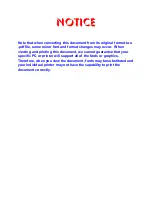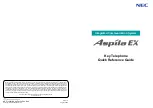
English
3
SYSTEM SETUP
BATTERY INSTALLATION
1. Slide the transmitter POWER ON/OFF switch to the OFF
position.
2.
AXU1, AXU1G: Press down on the OPEN side of the battery
compartment cover, slide it back and flip it open, as shown
in Figure 4.
AXU2: Unscrew the transmitter battery cover to expose the
battery terminals, as shown in Figure 4.
FIGURE 4. BATTERY INSTALLATION
Á
Á
Á
Á
Á
Á
Á
+
-
Á
Á
Á
Á
Á
Á
Á
Á
Á
Á
Á
Á
Á
Á
ÁÁ
ÁÁ
Á
Á
Á
Á
Á
Á
Á
Á
Á
ÁÁ
Á
Á
Á
Á
Á
Á
Á
Á
Á
Á
Á
Á
Á
Á
Á
Á
Á
Á
Á
Á
ÁÁÁ
Á
Á
Á
Á
Á
Á
Á
Á
Á
Á
Á
Á
ÁÁÁ
Á
Á
Á
Á
Á
Á
Á
Á
Á
Á
Á
Á
Á
Á
Á
Á
Á
Á
ÁÁÁ
Á
Á
Á
Á
Á
Á
Á
Á
Á
ÁÁÁ
Á
Á
Á
Á
9 V
ÁÁÁ
Á
Á
Á
ÁÁÁÁ
ÁÁÁ
Á
Á
Á
Á
Á
Á
Á
Á
Á
Á
Á
Á
Á
Á
Á
ÁÁ
ÁÁ
ÁÁ
ÁÁ
ÁÁÁ
Á
ÁÁÁ
Á
Á
ÁÁÁ
ÁÁÁ
Á
Á
Á
Á
ÁÁÁ
Á
Á
Á
ÁÁ
ÁÁ
ÁÁ
Á
ÁÁÁ
ÁÁÁ
ÁÁÁ
ÁÁ
ÁÁÁ
Á
Á
Á
+
- 9 V
ÁÁ
ÁÁ
3. Insert a fresh 9V alkaline battery into the battery compart-
ment (A Duracell MN1604 is recommended). A fresh 9V alka-
line battery will typically provide 18 hours of performance
time. A fully charged 8.4V NiCad battery will provide about
2 hours of performance time.
IMPORTANT: Carbon-zinc and zinc-chloride batteries will
not provide adequate power and are not recommended.
4. Replace the battery cover.
HEADSET ASSEMBLY
1. Refer to the tag attached to the headset for assembly instruc-
tions. After assembling the WH20, adjust the headband and
place it on your head.
2. Position the microphone over the corner of your mouth,
about 1/2 inch away. See Figure 5.
3. To reduce pops and breath noise, place the supplied foam
windscreen over the microphone.
FIGURE 5. HEADSET MICROPHONE POSITION
BODYPACK TRANSMITTER SETUP
1. Attach the transmitter to your belt, guitar strap, or waistband
as shown in Figure 6. Depress the tab marked PRESS and
slip the belt or strap between the transmitter body and the
belt clip. For added stability, draw the strap or belt toward the
clip’s top wire, especially when using thin guitar straps.
FIGURE 6. TRANSMITTER SETUP
2. Plug your guitar, headset microphone, or lavalier micro-
phone into the transmitter.
RECEIVER SETUP
1. Plug one end of the AC power adapter into the DC INPUT con-
nector on the back of the receiver.
2. Loop the power cable around the cable retainer on the bottom
of the receiver. See Figure 7.
3. Plug the other end of the AC power adapter into an AC power
source. The green POWER light on the receiver will glow.
FIGURE 7. POWER CABLE RETAINER
Á
Á
Á
Á
Á
Á
Á
Á
Á
Á
ÁÁ
Á
Á
Á
Á
Á
Á
Á
Á
Á
Á
Á
Á
Á
Á
Á
Á
Á
Á
Á
Á
Á
Á
Á
Á
Á
Á
Á
Á
Á
Á
Á
Á
Á
Á
Á
Á
Á
Á
Á
Á
Á
Á
Á
Á
Á
Á
Á
Á
Á
Á
Á
Á
Á
Á
Á
Á
Á
Á
Á
Á
Á
Á
Á
Á
Á
Á
Á
Á
Á
Á
Á
Á
Á
Á
Á
Á
Á
Á
Á
Á
Á
Á
Á
Á
Á
Á
Á
Á
Á
Á
Á
Á
Á
Á
Á
Á
Á
Á
Á
Á
Á
Á
Á
Á
Á
Á
Á
Á
Á
Á
Á
Á
Á
Á
Á
Á
Á
Á
Á
1
2
4. Connect the receiver output as follows:
•
AXUGD: Plug a standard guitar cable (two provided) into
the receiver’s output connector. Plug the other end into a
guitar amplifier, as shown in Figure 8.
•
AXUHD, AXU58D or AXULD: Use a cable with a 1/4 inch
phone plug or a female XLR connector to connect the re-
ceiver to a mic level input of a mixer or PA system, as shown
in Figure 8.
5. Extend antennas fully and point them away from each other
at a 45
°
angle, as shown in Figure 8.
Á
Á
Á
Á
Á
Á
Á
Á
Á
Á
Á
Á
Á
Á
Á
Á
Á
Á
Á
Á
Á
Á
Á
Á
Á
Á
Á
Á
Á
Á
Á
Á
Á
Á
Á
ÁÁ
ÁÁ
ÁÁ
ÁÁ
Á
Á
Á
Á
Á
Á
ÁÁ
Á
Á
Á
Á
Á
Á
Á
Á
Á
Á
Á
Á
Á
Á
Á
Á
Á
Á
Á
Á
Á
Á
Á
Á
Á
Á
Á
Á
Á
Á
Á
Á
Á
Á
Á
Á
Á
Á
Á
Á
Á
Á
Á
Á
Á
Á
Á
Á
Á
Á
Á
Á
Á
Á
Á
Á
Á
Á
Á
Á
Á
Á
Á
Á
Á
Á
Á
Á
Á
Á
SHURE
Á
Á
ÁÁ
ÁÁ
ÁÁ
ÁÁ
Á
Á
Á
Á
Á
Á
Á
Á
Á
Á
Á
Á
Á
Á
Á
Á
Á
Á
Á
Á
Á
Á
Á
Á
Á
Á
Á
Á
Á
Á
Á
ÁÁ
ÁÁ
Á
Á
Á
Á
Á
Á
Á
Á
Á
Á
Á
Á
Á
Á
Á
Á
Á
Á
Á
Á
Á
Á
Á
SHURE
Á
Á
Á
Á
Á
Á
Á
Á
Á
Á
Á
Á
Á
Á
Á
Á
Á
Á
Á
Á
Á
Á
Á
Á
Á
Á
Á
Á
Á
Á
Á
Á
Á
Á
Á
Á
Á
Á
Á
Á
Á
Á
Á
Á
Á
Á
Á
Á
Á
Á
Á
Á
Á
Á
Á
Á
Á
Á
Á
Á
Á
Á
Á
Á
Á
Á
Á
Á
Á
Á
Á
Á
Á
Á
Á
Á
Á
Á
Á
Á
Á
Á
Á
Á
Á
Á
Á
Á
Á
Á
Á
Á
Á
Á
Á
Á
Á
Á
Á
Á
Á
Á
Á
Á
Á
Á
Á
Á
Á
Á
Á
Á
Á
Á
Á
Á
Á
Á
Á
Á
Á
Á
Á
Á
Á
Á
Á
Á
Á
Á
Á
Á
Á
Á
Á
Á
Á
Á
Á
Á
Á
Á
Á
Á
Á
Á
Á
Á
Á
Á
Á
Á
Á
Á
Á
Á
Á
Á
Á
Á
Á
Á
Á
Á
Á
Á
Á
Á
Á
Á
Á
Á
Á
Á
Á
Á
Á
Á
Á
Á
Á
Á
Á
Á
Á
Á
Á
Á
È
È
Í
Á
SHURE
Á
Á
Á
Á
Á
Á
Á
Á
Á
Á
Á
ÁÁ
ÁÁ
Á
Á
Á
Á
Á
Á
ÁÁ
ÁÁ
ÁÁ
ÁÁ
ÁÁ
ÁÁ
ÁÁ
ÁÁ
ÁÁ
ÁÁ
ÁÁ
ÁÁ
ÁÁ
ÁÁ
ÁÁ
ÁÁ
Á
Á
FIGURE 8. WIRELESS SYSTEM OPERATION



























